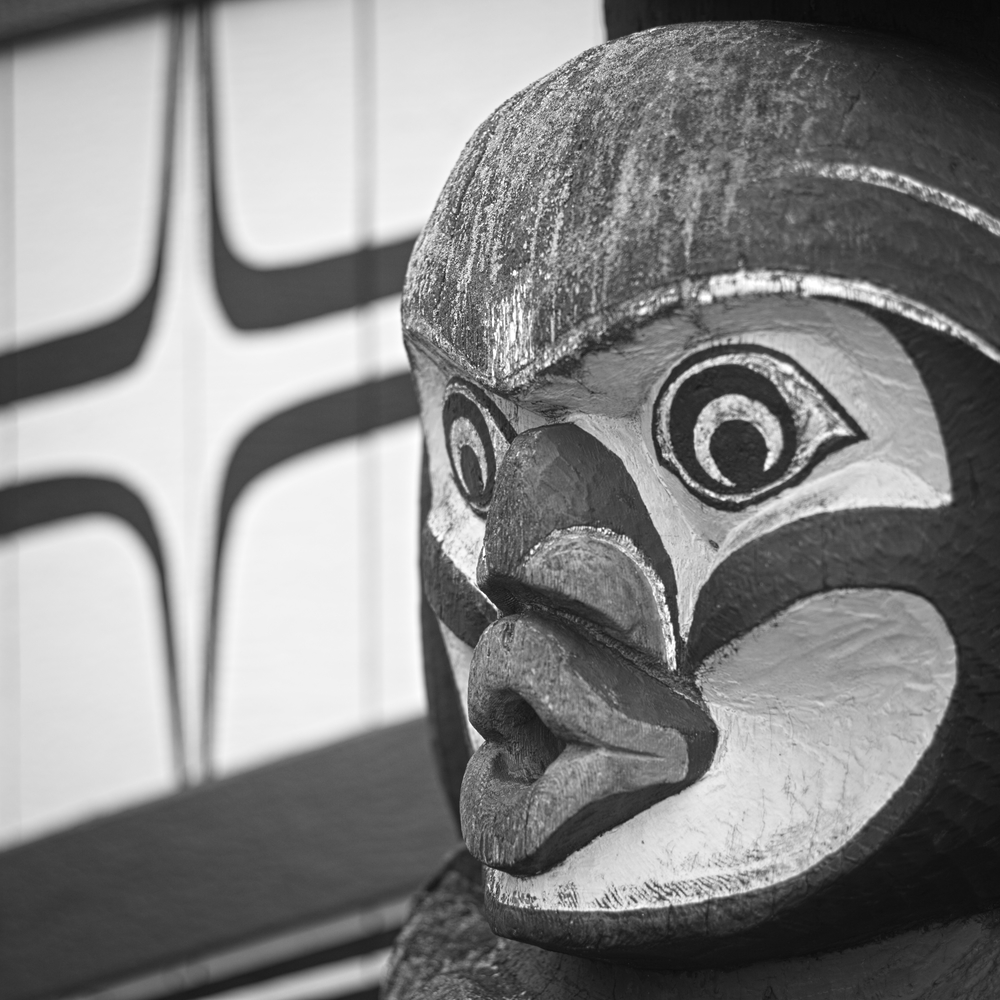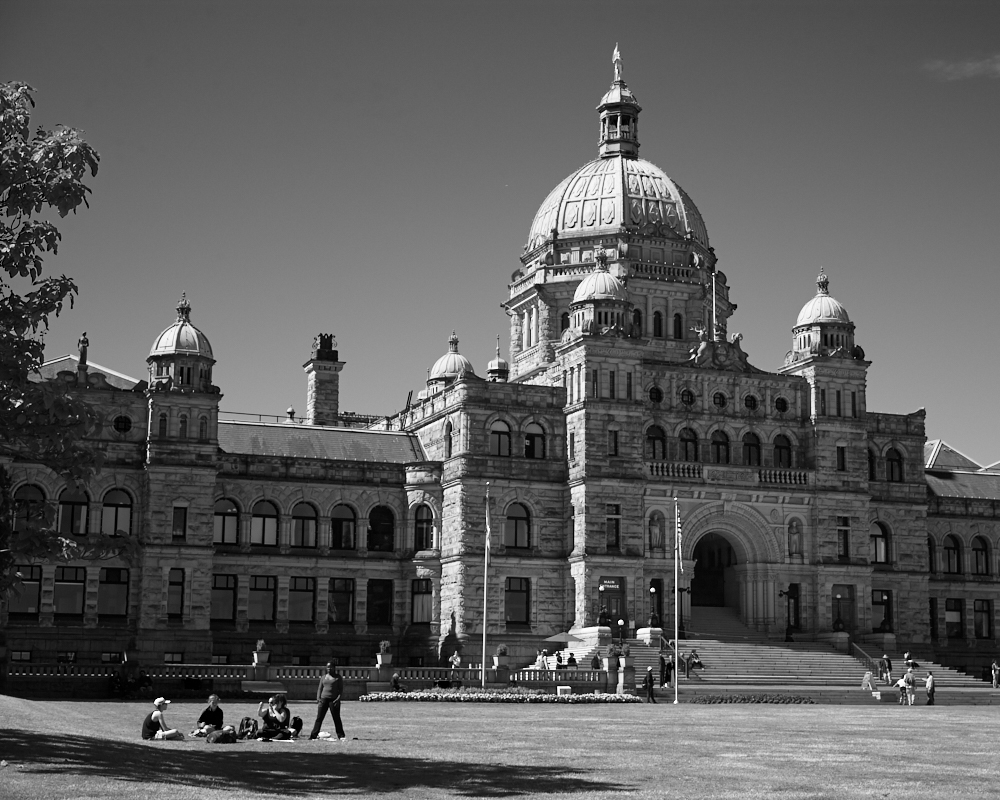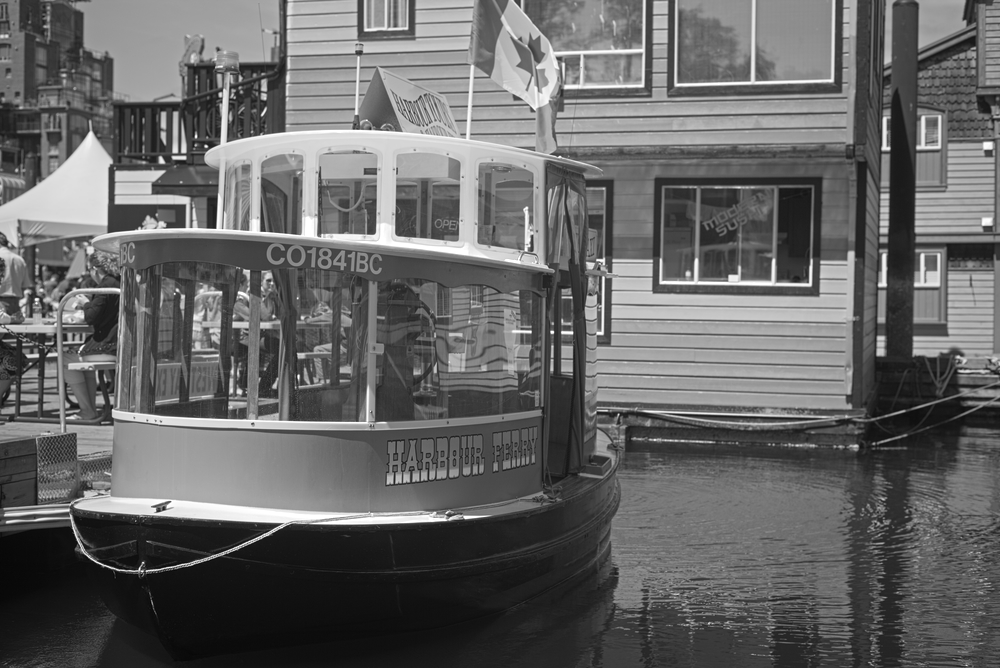The Salish Sojourn V
Victoria, British Columbia

Totem, Thunderbird Park, Victoria, BC
Our apartment is about a mile from the center of the city. In the morning, we walk along the Inner Harbour, past the floatplane base where the Otters wait for their morning customers. A small marina floats in the shadow of the Empress Hotel, across from the Victoria Clipper dock. Here three tall ships with their vast cats cradles of spars and rigging, strain at their lines, ready to take tourists out for cruises on the Strait of Juan de Fuca. Whale watching is also a big attraction. We see clients inserting themselves in baggy dry suits and climbing aboard a large rubber boat. Call me a purist, but if your vessel takes on so much water that you need a special suit to stay dry, you need a different boat. We move on.
For many visitors, the iconic Empress Hotel epitomizes Victoria. Opened in 1908, the hotel was originally built to house passengers of the Canadian Pacific Steamship line. Although the company folded, the Empress continued to welcome guests, and became one of the top attractions of Victoria. One goes there, I'm told, for high tea.
Sadly, the subtle appeal of high-priced Earl Grey and crumpets is lost on me. Even more sadly, perhaps, I do not find myself terribly interested in the upmarket appeal of the Empress. Mary and I stroll through its public areas, but there is no real temptation to linger. I can't imagine wanting to take a room here: give me my Chinatown apartment with its view of the pickle boats.

The Empress Hotel
Far more fascinating is the green space that stands directly south of the Empress: Thunderbird Park. Established in 1941, Thunderbird Park houses a large number of totem poles, as well as a First Nations longhouse. The park was originally intended to preserve totem poles that had been gathered from across Vancouver Island, but the original totems began to deteriorate in the weather. The Royal British Columbia Museum began a conservation/preservation program in 1951: the original poles were moved into the Royal British Columbia Museum and, over time, replaced by new poles carved by Chief Mungo Martin, Henry Hunt, and a group of their apprentices. Today, all of the poles found in the park are "new."
Totems are traditionally carved from red cedar, a rot-resistant wood. The craft probably originated among Alaska's Haida people, and spread south to the peoples of the Salish Sea. Although the arrival of Europeans on these shores was generally detrimental for indigenous populations, the art of totem carving received a boost. Prior to that unhappy first contact, native artists were forced to carve with blades made from stone or clam shells. This meant that the carvings tended to be small — it was too difficult to carve larger works with these tools. The Europeans brought iron blades, and the heights of the totems began to grow.

Totem, Thunderbird Park
The art flourished, but there was a European backlash as well. Many Christian missionaries believed the totems were idolatrous, and campaigned for their removal. By the early twentieth century, the carving of the poles had largely ceased; poles were destroyed or left to rot in the slow falling rain.
Public opinion changes, however, and as the twentieth century advanced, there was a revival of interest in indigenous arts. A new generation of carvers, including Chief Mungo Martin, began creating new poles, and today there is a flourishing community of artisans producing these works.

Totem, Thunderbird Park
Scholars argue about the meaning of the poles: standardized figures represent creatures from traditional stories — the raven, thunderbird, and bear — but these poles were never considered sacred or objects of worship. The totems may allude to mythical accounts, but there is no universal interpretative key that guides the use of figures, nor their priority on the pole. In short, one sees what one wants to see, and in a determinedly postmodern way, every individual creates their own interpretation of the artwork.

Totem, Thunderbird Park
The collection of totems at Thunderbird Park is magnificent. Spaced around a longhouse, also built by Chief Mungo Martin, they create a zone of silence in the heart of the city, a portal to a stunning past. Some of the figures are self-evident, others more obscure. I come away from the park wishing that I knew more about these figures and the stories they represent. That's the mark of a quality attraction: it leaves you wanting more.
Thunderbird Park stands just east of the Royal British Columbia Museum. A three story edifice, dedicated to the natural history of the province, it seemed a promising alternative when a wash of rain brought an end to outdoor sightseeing.
Unfortunately, all of the other tourists in Victoria had the same idea. A line snaked back and forth across the forecourt, as people queued for entry. When we reached the cashier's desk, another unhappy surprise: the ticket prices were as elevated as the line was long. Twenty-four dollars apiece. The Louvre doesn't charge that much! Nevertheless, it is the spirit of the thing, I suppose. When on holiday, you expect to be fleeced, and grudgingly pay while rationalizing the cost away as something "we won't soon have an opportunity to do again."
Having surrendered my credit card, as well as taking a lien out on my children's inheritance, we rode the escalators to the top floor of the building. Now, I will have to state, in the spirit of full disclosure, while it was stunningly overpriced, the museum really was quite wonderful.
The first exhibition focused on the lives of the indigenous peoples of British Columbia. Artfully lit totem poles, masks, and other carvings were mixed with displays about how their creators lived before the arrival of Europeans on these shores.

First Nations Mask, Royal British Columbia Museum
On the other side of the floor was a large exhibition that documented the life of the European invaders in the Province. Cleverly staged at the center was the main street of a late nineteenth century town, where you could walk between facades and peek in the windows. The major industries of British Columbia received recognition: near a replica of a saw mill was a placard that noted that even today, half of the money generated in the province comes from timber and wood products.
The second floor of the museum focused more on the "natural" part of natural history, with huge, walk-through dioramas of native forests and seas. The displays were incredibly life-like, and people were snapping pictures of a black bear emerging from the woods, undoubtedly to buttress stories about their ursine encounters on Vancouver Island.
We ended our visit with a walk through the current special exhibition on Mammoths. For whatever reason, this tribute to woolly pachyderms was immensely popular, and had drawn most of the people who were standing in line with us earlier. In other words, this series of rooms was heaving with people. I walked through it quickly, having reached my museum maximum. I don't know if this happens to you, but there comes a point in any museum or gallery, where my brain teams up with my feet and says, "enough: I can take in no more information, and I am tired of standing, shuffling slowly past exhibits." Museum maximum. Time to get out, even if you are in the presence of Lyuba, a 40,000 mummified baby mammoth discovered in Siberia in 1987.
I made for the exit. The exhibition, predictably, funneled all of its visitors into a gift shop, through which I was able to pass without succumbing to desire for a Mammoth sweatshirt, key chain, or any of the hundreds of alternate Mammoth-ware products.

Parliament Building, Victoria, BC
From prehistoric mammoths to politicians: the loop around the Inner Harbour runs past the Parliament Building, seat of government for the Province of British Columbia. It is an elegant edifice of sculpted stone and copper-clad domes. Completed in 1897, the Parliament anchors the southern edge of the harbor, kitty-corner to the Empress. It is also — shockingly — free to all who would like to step inside for a visit.
After waiting in a line to run our possessions through a metal detector — more security here than at the Canadian border — we gained entry to the seat of power. I noted that the toilet stalls in the men's bathroom are made of red marble. That is class. It makes me eager to see the rest of the building.
Unfortunately, there is not much more to see. Most of the building is closed to the public. You can peek into the Legislative Chamber, admire the stained glass windows installed for the Jubilee years of Queens Victoria and Elizabeth II, and gaze up at the under surface of the domes in the rotunda — but this isn't going to consume much of your tourist day. It is a working government building, and I suppose they don't want tourists popping in and out of the various offices, inquiring how the undersecretary of timber management is getting on. Quite understandable, but a little disappointing.
Continuing along the southern edge of the Inner Harbour, we reached another of Victoria's famous attractions, Fisherman's Wharf. This is a medium-sized marina which mixes floating houses, outside eateries, and a small fleet of commercial fishing boats.

Pickle Boat at rest, Fisherman's Wharf, Victoria, BC
Award-winning Barb's Place may be found in the heart of Fisherman's Wharf. Tucked in beside a Mexican seafood place and an ice cream shop, this seafood stand has allegedly been singled out as one of the top ten best places to eat on the North American coast by Sunset magazine.
Hmmm...
The problem, in my view, is that its popularity makes it untenable. The lines are long and the diners are all crammed into a few tables under a shady enclosure. There doesn't appear to be any room at the inn for us, and, frankly, I was looking for something a little more high end for lunch.
Miss Mary, however, knows how to press my buttons. "Look," she says, "they have oyster burgers."
This is a treacherous thrust, a calculated ploy designed to exploit my well-known weakness. A devilish gambit to be sure. I waver for a moment, then concede and join the line to place our order. I do love oyster burgers.
After placing our order, and paying an extremely reasonable sum for the food, I am given a device that appears to be a black plexiglass smoke detector. "When it beeps," I am told, "come collect your order at the window."
Hmmm.
Miss Mary has worked out a table-sharing arrangement with an older triplet: one man and two women. Although they are all well dressed, he puts us all in the shade, attired in a blue dress shirt, grey vest and tie, and a stylish grey ascot cap. If I had not exercised the forethought to wear my spiffy, khaki Domke photo vest over a dark green t-shirt, I would have felt very underdressed.
Their smoke alarm went off and the two women jumped to their feet, rattling the chap beneath the ascot cap. He collected himself, smiled apologetically, and as soon as his companions were out of earshot, he extracted a harmonica from an inner pocket. "Guess what song I'm playing," he said, and began playing a tune that was similar to, but completely unlike, anything we recognized. Before we could lock onto this obscure melody, his companions returned, bearing fish. Faster than a sardine leaping clear of a seal's teeth, the harmonica vanished in a twinkle of silver, plunging into a hidden recess beneath his grey vest.
"He's been entertaining us," said the ever-charitable Miss Mary.
The first woman put a shocking amount of scowl into an uplifted eyebrow. "Yes," she said, freighting that single syllable with an entire container ship of skepticism. "Your husband has been entertaining," she reported, when her companion reached the table with the rest of their order.
Goodness. He only gets out once or twice a year, let him have a blow on his harmonica, I thought. Before I could voice this strongly worded thought, our smoke alarm went off, and I was distracted by thoughts of oyster burgers.
Which, in fact, lived up to their billing. Kudos to Sunset Magazine for sniffing out this place, and well done Barb's Place for not relaxing on your laurels. Two immense oysters, wrapped in an airy — rather than greasy — breading, were presented in a cradle of shredded lettuce and diced tomatoes on a light roll. The French Fries were French Fries — drown them in enough tartar sauce, poached from Miss Mary's fish basket, and they go down a treat. But it was the oysters that made the experience. I would love to have a head-to-head competition, pitting Barb's Place against some of my favorite Long Beach restaurants and the incredible Willapa Bay oysters. Who would win? I couldn't say, but it is a competition I would be delighted to arbitrate.
The harmonica did not reappear for an encore. We finished our meal in silence, and then with an awestruck obeisance toward the oyster preparers of Barb's Place, made out departure from Fisherman's Wharf.
After a longish walk out to the coast to look at the Strait of Juan de Fuca, we retraced our steps to Fisherman's Wharf and caught a pickle boat home.
If you are enjoying this series, why not subscribe to Richard's monthly newsletter, What's New in Old News? The Peripatetic Historian is on the road, roaming the world and compiling fresh adventures. Don't miss out. Click here to join the legions of above-average readers who have already subscribed.